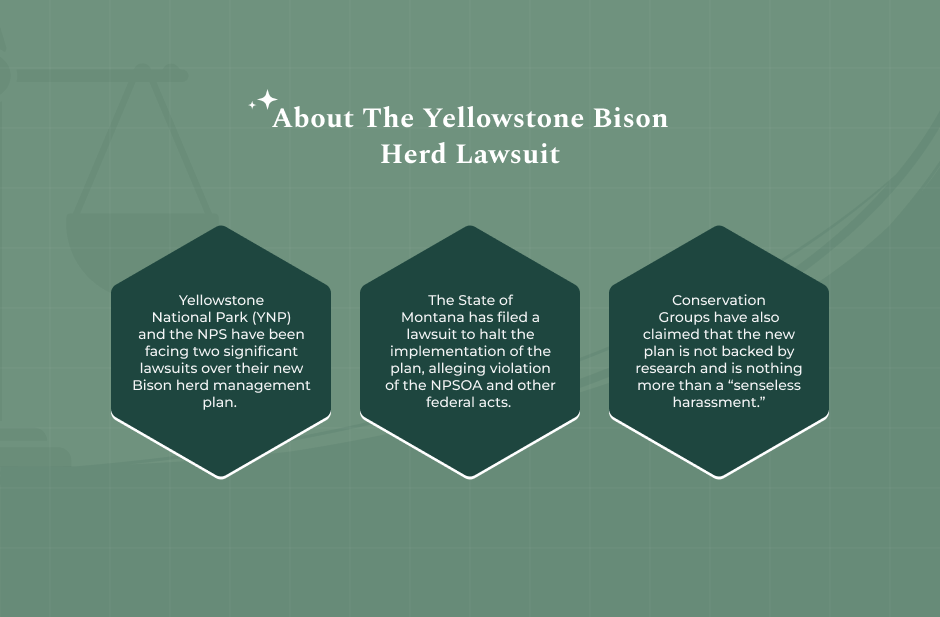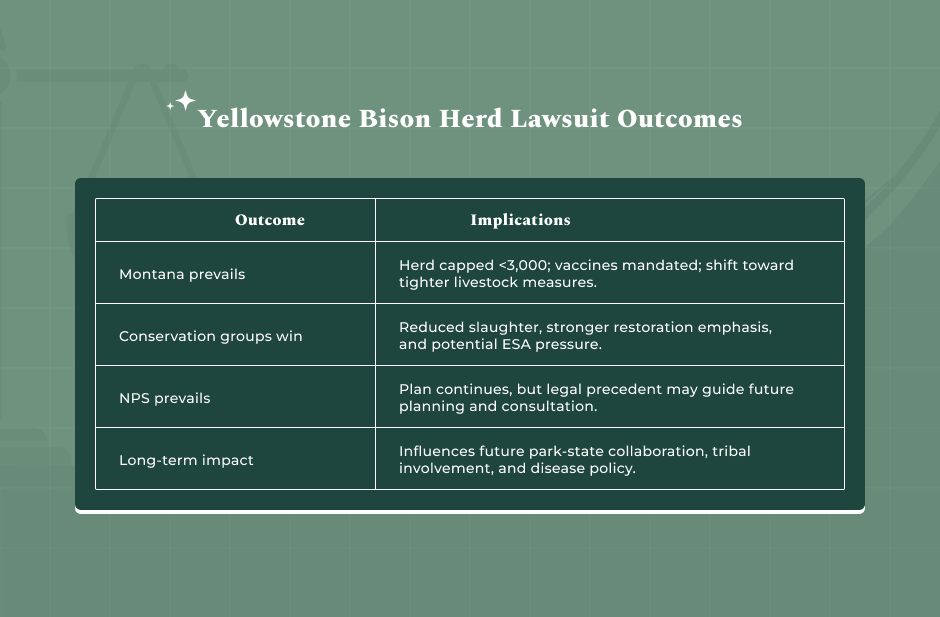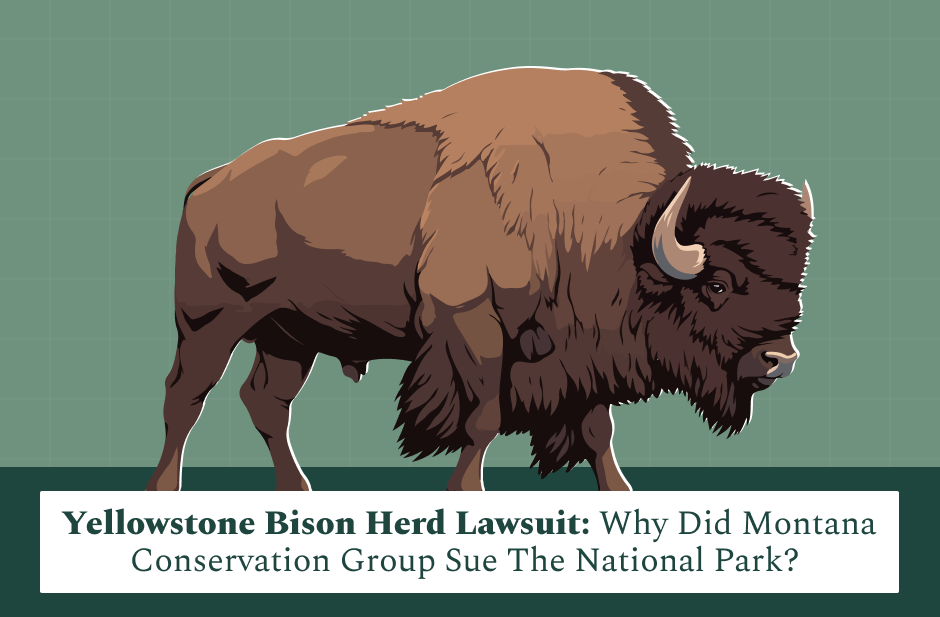- YNP and NPS have been struggling with two major lawsuits related to their Bison herd management plan recently.
- Montana has taken the case to court against the plan to stop it from being put into action. They say it goes against NPSOA and other federal laws.
- On the other hand, Conservation Groups funded a lawsuit opposing the new plan; according to them, it is a mere fabrication of the “senseless harassment” and is not supported by any research.
Yellowstone National Park is home to America’s largest and most iconic wild bison herd, a living symbol of resilience and a magnet for tourism and scientific interest.
In 2024, the National Park Service (NPS) introduced a new Bison Management Plan, aiming to manage herd size, update disease control measures, and incorporate new scientific insights.
Yet, instead of calming the debate, this plan triggered two significant lawsuits: one filed by the State of Montana, led by Governor Greg Gianforte, and another by conservation groups—the Alliance for the Wild Rockies and Council on Fish & Wildlife.
The lawsuits reflect two opposing drives: Montana’s livestock protection concerns versus conservation groups’ push for more robust wildlife preservation.
In this article, we will talk about the following things:
- The historical background of the Bison Herd Management.
- Changes in the new Bison Herd Management plan.
- About the ongoing Yellowstone Bison Herd lawsuit.
- The response from the NPS.
- Potential outcomes of the lawsuit.
Therefore, if these are some of the things that you want to know, keep on reading till the end…
Historical Background Of Bison Herd Management
Since the late 19th century, bison populations have been decimated, with populations plummeting from tens of millions to a few hundred.
Yellowstone preserved the last wild survivors, and recovery efforts have shaped modern conservation strategies.
However, in the year 2000, the government established the Interagency Bison Management Plan (IBMP). It involved the NPS, U.S. Forest Service, APHIS, Montana’s livestock and wildlife departments, and tribal partners.
Now, its goal was pretty simple:
- Maintain a wild, free-ranging Yellowstone bison herd.
- Reduce risk of brucellosis transmission to cattle.
- Manage bison migration outside park bounds.
- Sustain Montana’s brucellosis-free livestock status.
Eventually, as time went by, herd size fluctuated between approximately 2,400 and 5,500. Throughout this period, no documented case of bison transmitting brucellosis to cattle occurred, though elk have been implicated in several transmissions.
Yellowstone’s New 2024 Bison Management Plan: Did Anything Change?
In July 2024, the National Park Service (NPS) finalized a new plan related to Bison Herd Management. This was the replacement of the 2000 version.
While reading about this revised plan, two things stood out to us. Primarily, these were:
- The new herd target range was changed from 3,500 to 6,000 animals, raising the former upper limit substantially.
- It expanded the tolerance for herd roaming beyond the park’s northern and western boundaries, giving the bison “greater flexibility to roam beyond the tolerance zones.”
As per KBZK News, NPS stated that the decision to update the BMP was the “culmination of an Environmental Impact Statement (EIS) and National Environmental Policy Act process that began in 2022.”
About The Yellowstone Bison Herd Lawsuit

The state’s lawsuit primarily revolves around the demand to bring down the bison population in Yellowstone to 3,000 animals only. Among them, 5,400 bison are freely wandering in the park.
It is the demand that pops up in spite of the new plan laying out a population range that is far from the 10-year average. Gradually, this has allowed Yellowstone managers to keep bison and cattle separated.
As a result of this, there have been no brucellosis transmissions and only a few conflicts with landowners north and west of the park.
Above all, in order to meet the state’s objective of shooting more than 2,000 bison, the park will have to resort to an extreme and aggressive method of chasing bison. That is to say, they will be killing those bisons that are migrating towards the park boundary. Additionally, they will be also getting rid of those in Yellowstone’s interior.
Such measures can reduce the genetic pool of the herd to a great extent and may even endanger the population’s continuation over time. Most Tribal and public hunting opportunities will be gone as well.
At present, there are two lawsuits going on against NPS and Yellowstone’s Bison Management Plan. These are:
- Montana’s Lawsuit.
- Conservation Groups’ Lawsuit.
Let’s take a look at these two, shall we?
1. Montana’s Lawsuit Against Yellowstone
On December 31, 2024, Montana Governor Greg Gianforte, joined by the Department of Livestock (DOL) and Department of Fish, Wildlife & Parks (FWP), sued the Biden administration and NPS (among other defendants) to halt implementation of the new plan.
Why? Well, according to the official announcement from the governor’s office, NPS violated the National Environmental Policy Act (NEPA) by failing to incorporate Montana’s input during the planning process meaningfully.
Here’s what Gov. Gianforte stated:
“The National Park Service has repeatedly and consistently failed to engage with the State in a meaningful and transparent manner as required by law throughout the planning process…We will always defend our state from federal overreach.”
Additionally, the lawsuit also claimed that the implementation of the new plan would violate the National Park Service Organic Act (NPSOA) (and potentially the Yellowstone Park Protection Act), which mandates cooperative conservation and state involvement.
According to court documents, there are seven distinct claims for relief by the Montana government. These are:
- The BMP FEIS is based on inaccurate and false assumptions in violation of NEPA and the APA.
- A reduction in Montana’s tolerance zone is a reasonably foreseeable circumstance defendants failed to analyze, in violation of NEPA and the APA.
- The “no action” alternative represents an artificial baseline in violation of NEPA and the APA.
- Defendants were pre-decisional, in violation of NEPA and the APA.
- Defendants failed to cooperate with Montana, in violation of NEPA and the APA.
- The FEIS was not a “sufficiently detailed statement”, in violation of NEPA and the APA.
- The FEIS alternatives considered degrade up range and natural systems, in violation of the NPSOA, the YNPPA, and the APA.
2. Conservation Groups’ Lawsuit
Shortly after Montana’s lawsuit, on 17th January 2025, conservation groups, the Alliance for the Wild Rockies (AWR) and Council on Fish & Wildlife, filed their own lawsuit against the National Park Service.
As per Buckrail, these conservation groups condemned the new plan for enabling “senseless harassment and pointless slaughter” of bison.
The groups argue the plan doesn’t expand bison range or restore their natural range, instead relying on outdated assumptions leading to unnecessary kill-offs.
Furthermore, they allege that although studies have proved that the former brucellosis plan was working, the NPS plan completely ignored these recommendations from the 2020 brucellosis study that highlight scientific uncertainties and potentially harmful management strategies.
Additionally, Alliance For The Wild Rockies states, “Park Service also failed to analyze where and when natural Yellowstone bison migration paths might overlap with cattle grazing on Bureau of Land Management and Forest Service lands outside Yellowstone National Park.”
In their announcement, the Conservation groups mentioned that the new Bison herd management plan “fail[ed] to provide any rational reason whatsoever to continue hazing, capturing, and slaughtering the nation’s last herd of wild bison.”
What Was The Response From NPS & Tribal Supporters?
NPS and tribal authorities like the Fort Peck Assiniboine & Sioux Tribes argue the plan is science-based and balanced. As a result, it provides necessary flexibility while addressing all stakeholder concerns.
Superintendent Cam Sholly states that Montana had opportunities to contribute analyses and even submit alternatives. Additionally, they state that limiting the herd to 3,000 could threaten bison conservation.
Yellowstone officials pushed back, asserting that the 2024 management plan was properly put into effect after a fresh environmental impact statement identified Yellowstone as being able to sustain the new target range of 3,500 to 6,000 bison.
This is in line with the recent 10-year average of about 5,000 bison, as per the YNP record of decision from July.
YNP officials say this revised population goal represents not only changes in the landscape and public opinion since the 2000 plan was agreed upon but also significant changes due to research that has substantially altered the manager of wildlife and livestock’s understanding of the transmission of brucellosis.
Apart from the fact that fewer cattle are grazing near the park today, the researchers have concluded that elk are the source of brucellosis infection in cattle, whereas bison have not been infected and are not carriers.Furthermore, the tribal supporters emphasize the plan’s ecological and cultural importance, noting how bison connectivity supports tribal heritage and ecosystem function.
Potential Outcomes Of The Yellowstone Bison Herd Lawsuit
Here’s what the potential outcome of the Yellowstone Bison Herd lawsuit looks like:

At stake is not just how many bison roam Yellowstone. Rather, its how we balance wildlife restoration, agricultural safety, and collaborative management.
Montana’s lawsuit underscores economic and livestock protections. Additionally, conservation groups press for ecological integrity and humane methods. Furthermore, NPS and tribal partners advocate for adaptive, science-based management.
These cases could shape future national park governance, wildlife law, and Native American collaboration.
Will The Yellowstone Bison Herd Lawsuit Impact Tourists?
It is very doubtful that the Yellowstone bison herd lawsuit will directly affect tourists. Or even the access to the park in the immediate future. The biggest effects, if they happen at all, will be mainly about the following things:
- Small changes to visitors’ experience.
- Long-term changes to animal populations.
The suit challenges different management policies and population caps, not how they run the park. Thus, roads, visitor centers, and main attractions (like Old Faithful) will still be available.
The dispute is about whether authorities should lower the size of the bison population as Montana wants. Or be allowed to grow to maintain a viable genetically diverse herd. The latter is something the new plan of the National Park Service suggests.
- If the environmentalists/NPS win: Visitors will have the opportunity to observe a healthy bison population. This is something that is ecologically valuable and part of the park.
- If Montana’s suit succeeds: The court may order removal programs to become more aggressive. This would result in a gradual decrease of bison which in turn will lead to the reduction of bison sighting over time.
Most importantly, the lawsuit underscores the difficult issue of managing animals that do not recognize boundaries of the park. The park experience for the average visitor of spotting bison in the wild will probably remain the same during the legal process.
Read Also:

















